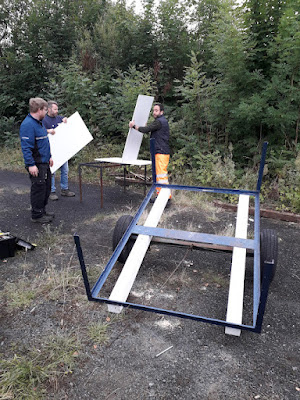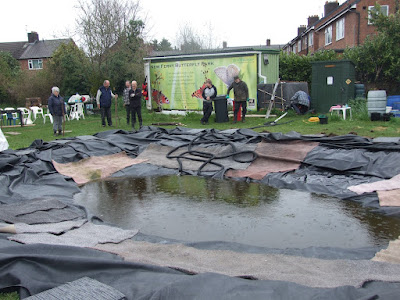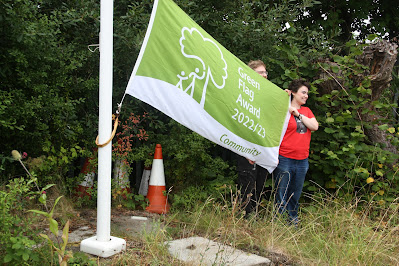 |
| Mr Mark Blundell, Lord Lieutenant of Merseyside opening the Silver Jubilee gates at the 2022 Open Day |
In July, there was a corporate workday for M&S Bank. They did not turn up, however the workday continued with one ton of gravel being spread next to the tool container and two 1000 litre water butts installed on the gravel bed. Thanks to Richard Sawdon for arranging the delivery of 4 x 1000L water butts and gravel and the plumbing in of two of these water butts. This allows the lower pond to be topped up. Charlie’s Field was also mown. Scything continued in July around the west of the pond and part of the BBQ grassland. Compost bins bays were relined with recycled plyboard from building site hoardings. July, a busy month at the park, finished with a workday with WSP when the mobile allotment trailer and trolley were repaired, and the rest of Charlie’s field was mown.
 |
| Fixing the mobile allotment trailer on a workday with WSP |
In September, the rest of the BBQ grassland was scythed, bramble removed from Charlie’s Field, compost bins turned, the remaining compost bays re-lined, and a volunteers’ BBQ held. In October, the calcareous grassland was rapidly scythed and reedmace was dug out of the Brick Pit Pond. A new venture took place - 25 litres of apple juice were pressed. Thanks to John Bateman for taking this initiative and carrying it out so well.
 |
| Juice pressed from apples grown at the Butterfly Park |
In November, a corporate workday was hosted, this time for Unilever. The overgrown hedgerow by 52 Windsor Close was dealt with, a third of the pond vegetation was removed in the lower pond, the acid grassland within the gates mown and half of Charlie’s Field got its second mow of the season. The November workday was the largest workday to date with seventy volunteers in all, 46 students coming from the University of Manchester. There was further scything of Charlie’s Field, coppicing on the embankment, hedge laying, and apple picking. Winter Coppicing on the embankment gave a harvest of 400 stakes and a pleasing primrose display in April. There was a good go at removing bramble and blackthorn from the rough calcareous grassland aided by the use of root slaying spades. Three morning sessions were held for Route to Success Students from Wirral Met, they removed ivy, bramble roots, coppiced buddleia, and cleared up brash.
 |
| Learning wheelbarrow skills with Route to Success! |
In January, thanks to Steve Yandell, a safe storage cupboard for gas cylinders was bought. In March, about 30 square metres of turf were removed from over the railway ballast area. In spring, Dingy skipper butterflies were spotted using these areas. Hiring a suitable chipper proved difficult but thanks to John Bateman a contractor was hired and over half the brash cuttings chipped. April saw the laying of a new membrane in the leaking pond. The vandalised notice board in Charlie’s Field has been repaired with stronger 4mm Polycarbonate sheeting. Charlie’s Field is steady improving in its flora as it receives a second cut in a year.
 |
| The new pond liner in place and some water returned to the pond |
June Mortazavi received an Eric Thurston Award from the Cheshire Wildlife Trust, partly for her input at the Park. Roy Lowry recorded and took photographs of invertebrates at the park and shared them on four excellent Wirral Wildlife blogs. His identification of hoverflies totalled 34 species over the season. City Nature Challenge had a recording session at the park.
.jpg) |
| June Mortazavi (centre) with Felicity Goodey, President of Cheshire Wildlife Trust (left) and Charlotte Harris CEO of Cheshire Wildlife Trust (right) |
At the end of open season, Alison Bailey Smith’s Eco Art flower sculptures were displayed around the park. Over the winter Yan and Charles revamped Mel’s Garden and have made excellent progress. They also sourced holly saplings and planted a holly hedge by 52 Windsor Close.
 |
| White clover (left), dandelion (middle) and spear thistle (right) sculptures made by Alison Bailey Smith from repurposed materials |
Despite increases in nectar sources and host larval food plants, butterfly numbers remained low except for holly blues which had their best year ever. This is in line with national and regional trends. Records of Dingy skipper and white letter hairstreak were highlights of the butterfly year. Other insects such as bumble bees and hoverflies seem to be doing reasonably well, though we do not have numerical records.
 |
| Dingy skipper, photographed at the Butterfly Park by Roy Lowry |
A lectern was bought in memory of Frank Cottrell, using funds donated in his memory at his funeral and by Wirral Wildlife. Frank also left a legacy of £500 to the park. A display about the history of the park (brick-making and railway) was put together by Pete Miller. Pete also did new displays for the siding lectern and the acid grassland lectern, so all three wooden lecterns now have seasonal sheets.
Thanks to all who have contributed their time and energy to the park in anyway, especially to; Linda Higginbottom for organising Sunday Wardens and visiting groups, Hilary for being the main host for Routes To Success sessions and John Bateman for moving us into the world of electronic donations. Also, Mike Maher for his weekly plant sales, Wirral Countryside Volunteers, Liverpool John Moores Conservation Society, and our corporate volunteers. Thanks to Steve Lyus for being chair for the last decade and for his valuable cool head during some of the challenges the park has faced. The park was awarded a Green Flag for the tenth year running.



No comments:
Post a Comment